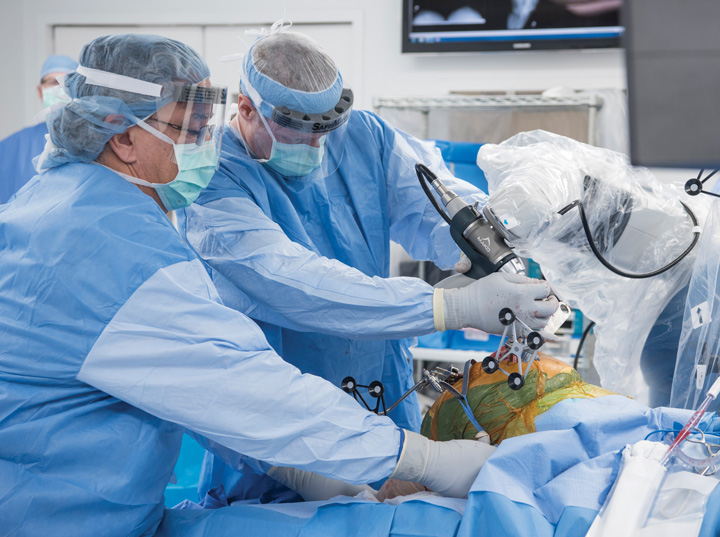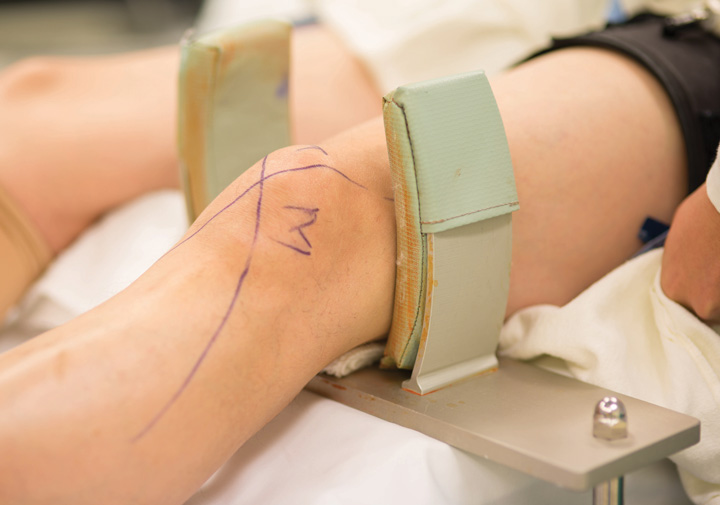- Home
- The Magazine
- Article
Is It Time to Add Knee Revision Cases?
By: Kendal Kloiber | Contributing Editor
Published: 5/8/2023
With this complicated procedure expected to grow dramatically, here’s what you need to know.
Though revision is sometimes seen as a partner to traditional knee arthroplasty, the two are very different. Revisions are typically longer, more complex cases that require a special set of knowledge, tools and techniques that are not a part of every orthopedic surgeon’s repertoire.
“With a standard joint replacement, the term ‘knee replacement’ is actually a pretty aggressive term,” says Frank Liporace, MD, an orthopedic surgeon who is senior vice president for the musculoskeletal service line for RWJBarnabas Health’s northern New Jersey region. “A standard knee replacement typically impacts just a small surface of the knee, with most cases needing only a thin amount of the area resurfaced and capped with metal and plastic pieces.”
While some revision cases result from poor outcomes from primary arthroplasty or surgical infection, usually it’s the patient’s daily life that eventually causes the need for a revision —often falls or just normal wear and tear. That’s part of what is driving the expected growth of knee revision procedures in the coming years, along with more patients living longer.
“All implants have a life span,” says Michael P. Ast, MD, orthopedic surgeon and chief medical innovation officer at the Hospital for Special Surgery in New York. “The maturation of older implants can be thought of similarly to the tread on your tires. Eventually, you’ll have to replace your tires, even if the tires were good for many years.”
With this complicated procedure expected to grow dramatically, it’s important to get it right. If you’re considering adding knee revision cases, here’s what you need to know.
Preoperative planning

Though revision and replacement surgeries may sound similar at first glance, they actually are vastly different procedures with much different complexity.
“Revision surgery, unlike primary surgery, is much less predictable,” says Dr. Ast. “The key to revision surgery is having multiple plans in place. When you go into a native knee, you know what to expect, shape and adjust in a more predictable way. When you go back into a knee that’s already been operated on, there will be variable amounts of scar tissue, and potential damage to bone or ligaments inside the knee itself.”
Because of this added level of complexity, preoperative planning is essential to a successful revision. First, you must understand why the patient needs a revision in the first place, says Dr. Liporace.
“If it’s due to fracture, we need to assess if we’re able to save that area of the bone and work around the existing joint, or remove the shell of the fractured bone and joint and use a specialized prosthesis that will replace the fractured bone,” says Dr. Liporace. “If it’s just the end of the implant’s life cycle, we still need to assess bone quality to realize how aggressive we need to be.” During this preoperative planning, questions may include how stable the knee is, the quality and function of the ligaments, what type of augments will be required and more.
“The key to revision surgery is to have plan A, B, C, D, E and F,” says Dr. Ast. “You should have five or six plans in place. Plan A may be that you believe one part is loose, so you plan to leave everything alone and just replace that part. But then when you get in there, and there’s something else broken or when you remove that part there’s damage to the ligament, you have to go to plan B, which is a different implant or replacing a part that wasn’t in your plan A.”
If a patient presents with an infection in the knee, an entirely different approach is required. Dr. Liporace notes that infections are sometimes easy to miss, since symptoms can range from simple mechanical instability all the way to a red-hot knee with drainage. For these patients, it’s critical to first confirm that there is an active infection and then plan for a two-surgery approach, with the first procedure cleaning out the joint and then inserting a temporary joint replacement that’s coated in antibiotics, before doing a final procedure once the infection clears, says Dr. Liporace. It’s also important to consider the health of the patient since they are typically very different from your standard outpatient knee replacement patient.
“These patients have often had their replacements in for 20 years,” says Dr. Ast. “They’re often older and less healthy, undergoing what will be a much longer surgery. While the first time they may have been in surgery for one to three hours, a revision procedure in some extreme circumstances could be seven or eight hours.”
Post-op care also must be planned for more extensively, he notes. It must be more robust for these patients, whether it’s in the ICU or with specialists who can handle more complicated patients. “It’s a challenge for any facility,” adds Dr. Ast.
Tools, techniques and technologies

The tools, techniques and technologies are also vastly different from primary knee replacements, both doctors note. In revisions, you will use different implants as well as augments like sleeves and stems to help put the bone and ligaments back into good working order. Specialized instruments are needed to help judge how and where the deficiencies are in the bone and ligaments, says Dr. Liporace.
There’s also a difference in the sheer number of trays required. For a primary knee arthroplasty, Dr. Ast notes, three to five trays may be required for the procedure. But when he’s preparing to do a revision, he needs much more instrumentation to be ready, depending on how he must adapt while actually inside the knee. Even the implants themselves have dozens more pieces compared to a traditional implant. “An implant for traditional knee replacement usually has three parts,” says Dr. Ast. “In a revision, each of those parts can have 12-plus other parts.”
These implants require augments — think of a shim that can be used to square out a doorway — to get the implant to fit just right.
“If you do the math, there are hundreds of variations and options you can end up with,” he adds. While navigation and robotics have hit traditional joint replacements, they are starting to move into the revision space as well. Dr. Liporace says there are some navigation capabilities to get the right balance of the knee and a full range of motion. These systems are separate from the navigation and robotics of traditional arthroplasty, he adds. The two systems — one navigation and one robotics — have entered the U.S. market recently, which means they aren’t widespread yet, according to Dr. Ast.
“It’s still a tiny part of revisions,” he says. “There are a few centers utilizing this technology, but it’s not widely used, and many are in early limited market releases. The vast majority of surgeries are done with traditional instrumentation — that is wildly different and significantly more complex than first-time surgery.”
Growing practice
While it may seem worth exploring at first glance, be aware that adding revision procedures to an outpatient setting is still quite uncommon — and for good reason, says Dr. Ast. Challenges like needing a very large OR, or purchasing pricey implants that can cost more than $25,000, are just two reasons why.
“If you do 600 to 800 primary joint cases annually, and your surgeons are already doing a large percentage of revision cases, somewhere in the 15-30% range, then maybe someday you could consider it,” says Dr. Ast. “But from an operational and financial standpoint, it is extremely challenging.”
Like snowflakes
While those logistics are part of the challenges, patient demographics and the need to have a highly specialized team can make adding this procedure a challenge. “For revision joint cases, you need to have a very experienced surgeon with a thorough workup, a great radiology department and strong SSI department, and a team with a lot of overall experience,” says Dr. Liporace. “Revisions are like snowflakes. Each is unique. Some are just an exchange of a worn-out part, while others have major structural bone instability or infection. The first type may be possible in outpatient, while others will absolutely require a hospital stay.”
Just because primary knee replacement works in an outpatient setting doesn’t mean revisions will, adds Dr. Ast. “Revisions are completely different operationally and clinically, and we need to think of it that way. These are not the same surgery just because ‘knee replacement’ is in the name.” OSM
.svg?sfvrsn=be606e78_3)
.svg?sfvrsn=56b2f850_5)